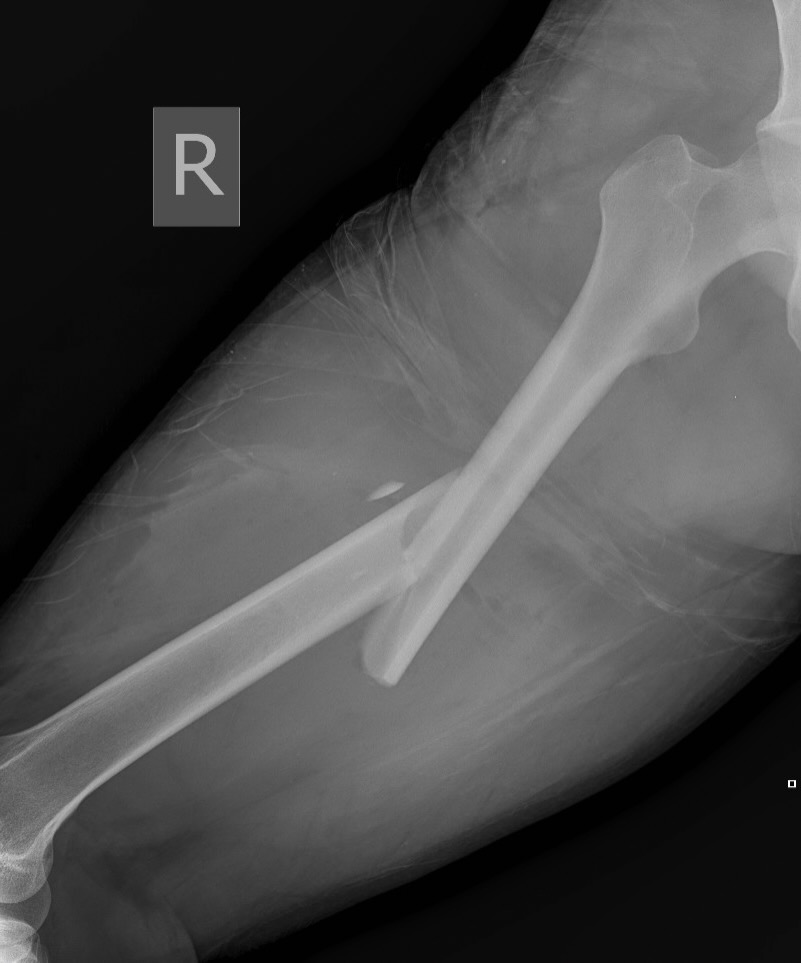At 4:30pm on Friday afternoon, just as I am winding down the workweek, I am notified that we have an open femur fracture in the emergency room. A 37-year-old man was hit by a truck while riding his motorcycle that morning. He originally went to the state hospital ten minutes away, but there is no capacity to care for these injuries there.

fractured femur
When I got to the ER, I saw the blood soaked through the bandage and his thigh severely deformed and limp. His vital signs were stable, hemoglobin levels low, and an x-ray showed a midshaft femur fracture. Our orthopedic resident labeled the injury as impotence de la membre inferieur.
Barely one hour from the time of arrival, he is on the operating table and spinal anesthesia is administered. Antibiotics are given. We roll him on his side and make sure he is secure. The nurses bathe his leg in betadine, and set up the sterile drapes to protect against infection. Then, as is our routine, we say a pre-operative prayer.

femur post-operation
During the surgery, we deliver the bone ends through the wound and wash, scrub, and scrape them clean. After making sure the central cavity of the bone shaft is big enough for our 9x400mm SIGN (Surgical Implant Generation Network) nail, a one-inch incision is made just above the hip, and the nail is placed inside the bone and across the fracture.
SIGN, which is celebrating its 25th anniversary, is a modern-day miracle. Lew Zirkle, an orthopedic surgeon in Richmond, WA, started the foundation, recognizing the need for an affordable implant to stabilize long bone fractures in the developing world. In resource-limited environments, femur and tibia fractures often create a lifetime of disability. But thanks to SIGN, we can access implants and equipment to treat fractures to the highest standard. SIGN manufactures implants, teaches surgeons, and has created a sustainable supply chain program for collaborating hospitals. These implants have treated over 425,000 long bone fractures in 57 countries.

SIGN Nails
Back in the operating room, we check the alignment and rotation and then secure the implant with two screws at each end. We wash the wounds again, suture the closed incision, and then place sterile dressings. The fixation is solid, and the patient will be able to walk with no particular precautions.
There are standing orders for Saturday morning physical therapy, which also mobilizes our patients to the hospital chapel. I fully expected our patient from the previous night not to make it to the chapel. He had undergone a big, painful operation and had just survived a major trauma.
To my surprise, I saw him walking independently with crutches! He made it down the hall, around the corner, and out the door to the hospital chapel. He sat down with only slight unease while juggling his crutches and IV bag. While he did not make it on his knees for the prayer, he stood for the songs and stayed for the entire service. I guess there are no more excuses for skipping church if tired or not feeling good!

Worship at the HAH Chapel

Saturday morning physical therapy returning from the chapel.
Discover more from haitibones
Subscribe to get the latest posts sent to your email.





Beautiful story! No doubt the power of prayer promotes healthy healing of mind and body!